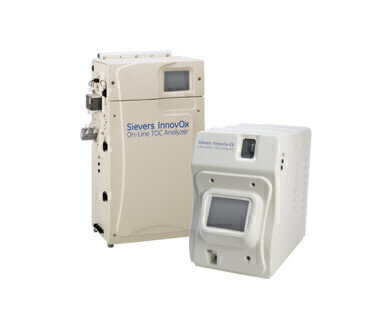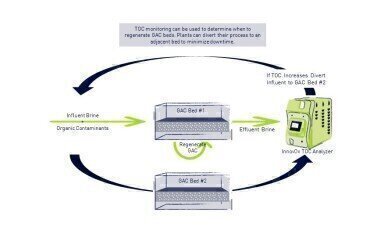Environmental Laboratory
TOC monitoring of brine for GAC optimisation and quality
May 08 2019
As global demand for chemical products continues to increase, so does the need for efficient industrial processes to support this production. One commonly recognised technique is the chlor-alkali process which involves the passing of an electric current through an aqueous solution of brine in a membrane cell. The electrolysis of these high salt solutions is used to produce hydrogen, sodium hydroxide, and chlorine. These products can then be further processed and purified into a variety of commodity chemicals. One example is trichloroisocyanuric acid, a disinfectant that prevents the rapid degradation of chlorine in swimming pools.
A large chemical plant in Spain that produces trichloroisocyanuric acid faced several challenges with optimising its production process. Although this plant utilises 28% brine for electrolysis, one of the final byproducts is a diluted 8% brine solution which can contain residual cyanuric acid. To save money, the plant purifies and concentrates this 8% brine to be reused.
However, increased levels of residual cyanuric acid and its derivatives can cause rapid degradation of the membranes used in the electrolysis bath. To remove these organics from the brine and extend the life of the membranes, the plant utilises a common purification technique known as Granulated Activated Carbon, or GAC. When passed through the GAC, the organic contaminants in the 8% brine adsorb onto the activated carbon bed. The resultant effluent brine, now free from residual organic contamination, can be effectively concentrated and reused in the electrolysis bath.
Over time, organic contamination accumulates onto the activated carbon and eventually the GAC bed needs to be regenerated. Once exhausted, the GAC loses its effectiveness, resulting in increased levels of total organic carbon (TOC) in the effluent brine solution. To ensure the health and longevity of the membranes, as well as keep the production process free of organic contamination, this plant needed a way to measure the organics in the process brine and monitor the effectiveness of GAC beds.
Solution
The Sievers* InnovOx Total Organic Carbon (TOC) Analyser, available in both a lab and online model, has proven to be a versatile and robust solution for a variety of challenging applications such as brine quality monitoring. The plant was able to optimise and monitor its production process in real-time by choosing the Sievers InnovOx On-Line, equipped with 4-20 output and MODBUS capability. Here TOC acts as a tool to control brine quality for high efficiency detection of cyanuric acid and any additional organic compounds in the brine byproduct.
When the GAC bed is operating optimally, the effluent brine typically contains low levels of TOC, thus confirming efficient organic adsorption and brine quality control. Increasing levels of TOC in the effluent indicate that the activated carbon bed is becoming exhausted and is no longer effectively removing organic contamination. When TOC levels in the effluent brine reach a predetermined threshold, a signal is used to divert the brine to an adjacent fresh GAC bed. Operators can then regenerate the exhausted GAC bed without interrupting production.
Results
The Sievers InnovOx On-Line, which utilises patented Supercritical Water Oxidation (SCWO) technology, provides real-time TOC data to optimise the chlor-alkali process at this plant. SCWO technology enables InnovOx to oxidize organics efficiently even in high salt streams. An example of this is seen with chlor-alkali brine, which traditional combustion TOC analysers cannot handle without extensive maintenance. The InnovOx allows the plant to control its process by effectively monitoring the organic content of the brine byproduct. Rapid analysis and real-time data, coupled with 4-20 output to PLC, enables the plant to immediately switch GAC beds as soon as the prior bed is exhausted. This not only prevents organic contamination from reaching the electrolysis membrane, but also ensures that the plant can continue to run with minimal downtime or disruption to production. By efficiently oxidising organics in challenging matrices such as high salt levels of chlor-alkali brine, Sievers InnovOx has proven to be the right choice for some of the toughest wastewater and process streams in the chemical industry.
Digital Edition
IET 34.2 March 2024
April 2024
Gas Detection - Biogas batch fermentation system for laboratory use with automatic gas analysis in real time Water/Wastewater - Upcycling sensors for sustainable nature management - Prist...
View all digital editions
Events
Apr 22 2024 Hannover, Germany
Apr 22 2024 Marrakech, Morroco
Apr 23 2024 Kuala Lumpur, Malaysia
Apr 23 2024 Kintex, South Korea
Apr 23 2024 Edmonton, AB, Canada



















